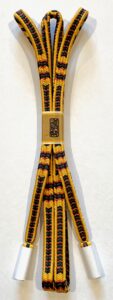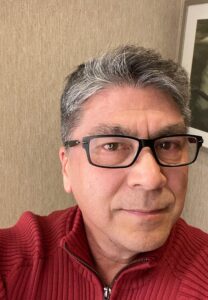The Missing Link – Linked Structures on the Marudai
Michael Hattori
 You look at a kumihimo braid and see a color pattern which would normally pass from front to back, back to front, but it remains somehow on one face only. “How did they do that?,” you think. Same head-scratching when you see a braid which repeats for much longer than would seem possible.
You look at a kumihimo braid and see a color pattern which would normally pass from front to back, back to front, but it remains somehow on one face only. “How did they do that?,” you think. Same head-scratching when you see a braid which repeats for much longer than would seem possible.
Michael unlocks these mysteries by taking you on an exploration of the technique used to accomplish this seemingly impossible feat: linking. If you’re ready for next-level marudai braiding, this is your rare chance to learn from a master!
This workshop is for those experienced with marudai braiding – no basics will be provided, including setting up the marudai. The core of this workshop will be analysis, so you should be interested in, and have some basic understanding of, braid structure.
SKILL LEVEL: Students must have a good deal of experience with marudai braiding. No basics will be covered or provided, including setting up the marudai. Experience with the Mitake braid preferred, as this is the braid we will center on for learning. If you have not done it before, do it before you come.
EQUIPMENT: Marudai, 32 tama (70, 85, or 100g), counterweight, chopstick, scissors, paper or notebook, pencils.
PRE-WORKSHOP PREP: Mitake braid review/practice as mentioned in Skill Level section above.
MATERIALS FEE: $40 – includes 2 pre-made 32 tama warps, instruction book, workbook.

Michael Hattori began his study of kumihimo back in 1979 during a year abroad at Waseda University in Tokyo, through a serendipitous connection with the famous Dômyô school via his homestay family. Kumihimo was instantly a passion for him, and it has become a nearly lifelong study.
In 2000 he met Richard Sutherland, who had organized a once-in-a-lifetime gathering of Japanese kumihimo masters in San Francisco. At that event, Michael met and began studying with Makiko Tada. Shortly after that, he also met the Andean and Kumihimo master, Rodrick Owen at the yearly workshop in Ft. Bragg, California.
Since then he has studied all forms of kumihimo, centering on takadai and marudai braiding, and braid reconstruction. He has taught at numerous conferences and written several articles on kumihimo. He is also currently doing iconographical research on the history of kumihimo, with plans to write a book.
He has just retired from 26 years as a Registered Nurse. He plans to spend as much time as possible in Japan furthering his kumihimo knowledge and skills!
